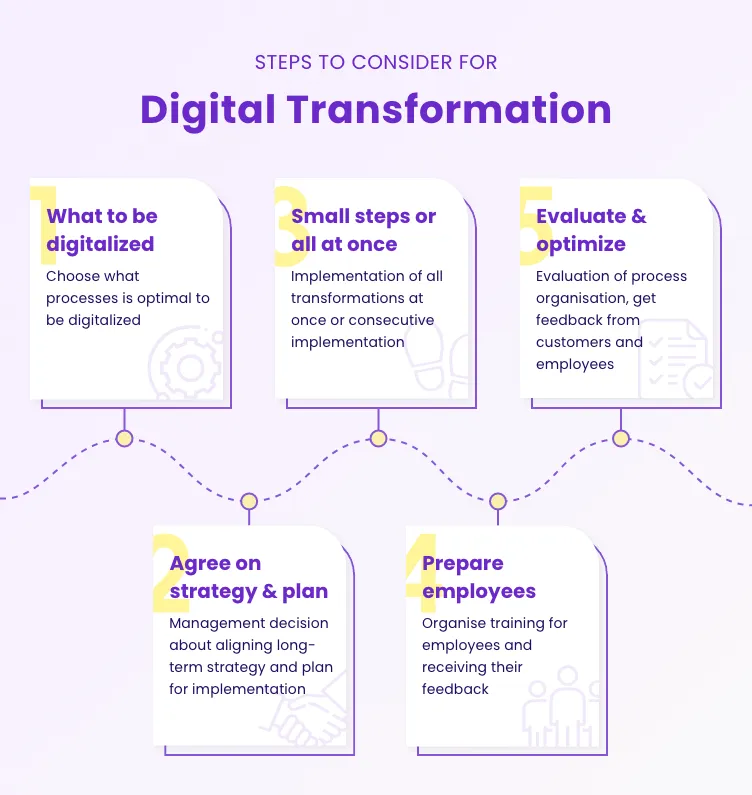
What is a digital transformation strategy?
A compiled and effective digital transformation strategy combined with business innovation can help every company meet the new needs of the market: improve customer relationships, internal processes, and value propositions.
With the imposed teleworking, forced by the COVID-19 lockdown measures, companies have to show adaptivity, implement agile procedures, cross-functional teams, and working business operations, and most importantly, do it overnight.

An international survey (McKinsey, 2020) shows acceleration normally achieved in 3 to 7 years has been realized for the period between December 2019 to July 2020. Talking about Europe - a survey performed by the European Committee of Regions, for the indicated period – indicates that digital interaction with customers has raised from 32% to 55%. “Same tendency is shown for products and/or services which were partially and/or fully digitized”. In addition, 8 out of 10 Europeans (81%) feel that by 2030, digital tools and the Internet will be important in their lives.
As a logical consequence “digital adoption has taken a quantum leap at both the organizational and industry levels” (McKinsey, 2020). Executives in all industries are already using digital technology and artificial intelligence such as data analytics, mobility, optimized processes, and smart embedded devices in order to improve their business model and meet the new inquiries of the digital age.
Digital transformation strategy: from should to must
Strategical repositioning in the digital age has imposed new digital transformation challenges requiring the introduction of digital enterprise strategy and new technologies solutions.
What exactly is a digital transformation strategy?
In addition to the business model transformation that is the most obvious, internal business procedures had to be audited and atomized too - new times required also a digital business transformation of already embedded technologies such as ERP and CRM and possibly the introduction of new technologies - in order to improve revenue growth, customer experience, and operating models.
The digital transformation projects were brought to the table of almost any executive – a strategic objective that was identified as essential but not a top priority for years. For the entire business, it included changes to business models, innovations to existing products and services, the development of new business models, and the definition of KPIs aligned with new digital solutions and emerging technology in order to meet the changing needs of customers.
The company culture needed to be transformed and adapted to this new reality as well as new digital business models needed to be defined. Managers had to gain a much more robust picture of their employees’ skills and workload in order to re-do the Tetris of a working process organization in the most optimal way. Thus, relying on real-time reporting, and smart data analysis tools in defining your digital transformation roadmap is crucial.
Is digital transformation suitable for any business?
Collecting data, automatization of processes, and storing on the cloud - еven for huge factories with many manual processes, digital transformation of the entire business is not a utopia but can be a reality. As a digital transformation strategist, we helped a globally managed cybersecurity company by improving its sales processes through business transformation and automatization of the entire sales lifecycle.
Emerging technology that let you obtain data in real-time can improve business outcomes and speed up management decision-making, making it much more knowledge-based and serving better the business objectives of the company.
Still, an important aspect is to be made an adequate analysis aiming at restructuring and optimization so each legacy technology is replaced for better business processes.
Another important question to be addressed is the company culture and its employees’ adoption. New technologies should complement and simplify business processes - not the opposite. Employees can be your compass when implementing and can give valuable insight or ideas.
Does your business need a digital transformation strategy?
Fast-evolving markets such as financial services and healthcare industries are in most need of a digital transformation strategy. Digitalizing those businesses and modernizing their processes and models is crucial to keeping pace with change and retaining customers.
For instance, digital transformation in healthcare optimizes the delivery of health services by automating repetitive tasks in the healthcare sector, making medical consultations faster, and allowing patients to communicate easily with healthcare professionals.
Other advantages of digital transformation in the healthcare industry are the ability to keep electronic medical records, improve diagnostics, have medical imaging and drug prescription, and boost the prevention and forecasting processes on both individual and community levels.
How does digital transformation help your business?
Мanual spreadsheets and inflexible procedures are innovation killers. Competitive companies modernize their processes and use technology to access comprehensive data to fuel decisions and speed delivery.
Some benefits of the digital transformation strategy include:
- Drives innovation by developing new services and products
- Speeds up strategic funding and resource allocations
- Measures digital transformation value
- Advances organizational agility to operate at the speed
- Enhances time-to-market and decreases cycle time
How to create a digital transformation strategy?
A coherent plan of action is a must. Your digital transformation strategy provides the steps and the action plan born from your “discussions and ideas”. Start by assessing your current condition through an Agile lens to select your desired end result. After identifying potential problems that may come on the way and the opportunities in your field, clearly define the KPIs and goals of the digital transformation.
Include specifics, such as the technology, people, teams, project managers, and budget required to enable the transformation process.
Remember, leadership sets the “why” in the digital transformation strategy and teams develop the “how” to deliver.
Digital transformation strategy action points

-
Choose what to be digitalized and optimized
Sometimes digitalization of some processes can consume more time and effort and still not bring the needed clarity and could actually complicate the process rather than simplify it. Thus, a careful evaluation is of utmost importance, in order to avoid mistakes and investment of workforce and resources into digitally-not-compatible processes.
Alignment with the company’s strategy and customer satisfaction is important and should be the lodestar for guiding the process.
-
Agree on strategy & plan
In the realization of any kind of change – both the ultimate goal and steps to be taken have to be endorsed by the management of the company and if possible – all important stakeholders. Agreement on the long-term digital transformation strategy is the backbone over to build the action plan with concretely defined steps, operating and business models, and roles.
This phase might take a long time to prepare since it needs careful evaluation of the existing organization but together with the first step – is crucial. Working with an external partner can save you time and workforce by counseling the process and sharing working examples gained through the realization of similar processes with other companies.
-
Work with your employees as advocates
Employees CAN and SHOULD be your partner for cultural changes.
They can give valuable advice about the small details in the process structure but also should be aware of resistance to the change – nobody goes out of their comfort zone with a smile. In case there is an external company supporting you in the change – require thorough training to be organized for employees as well as sessions for receiving their feedback once the digitalization is implemented and has worked for some time.
-
Evaluate and optimize
It is not a coincidence that many of the project management diagrams are circular. Once all changes are implemented and have started working follow a process of assessment and optimization. Constant improvements are possible and setting too short or long time can deviate from the objective evaluation.
How to measure if the digital transformation strategy is working?
Every winning digital transformation strategy should have measurable key performance indicators (KPIs), a clear outline of the business process supported by digital transformation means, and in an ideal case - a chief digital officer to overlook the following of the plan.
Not only for traditional companies but also for those following new business models it is important in those transformation projects to be incorporated the business outcomes so to be sure in the end will be on the same page with both customers and management or can even have a competitive advantage.
Key performance indicators to consider in your digital transformation strategy
What is important to be considered: Look at strategic impact (e.g., revenue growth, the satisfaction of customer pain points, lifetime customer value, time to market), operational impact (e.g., productivity improvements, scale, operational efficiencies), and cost impact.
And how to achieve it: collect the data (e.g., use artificial intelligence, analyze customer experience, use data from social media or machine learning), define clear transformations and strategic objectives (e.g. digital transformation means, existing products and new technologies, digital initiatives, chief digital officer), realize and evaluate.
The objective is to have an Agile mindset as you approach digital transformation, one that allows you to fast pivot strategies to respond to change.
3 key trends in digital transformation
Enabling the remote work
According to Forbes, the post-pandemic future of work predicts a huge need for digital transformation for seamless remote collaboration between teams. To improve the meeting equity, we can expect to see some innovative software and hardware solutions. Intelligent cameras fitted with AI will transform regular group meetings, making it easier to identify speakers.
The tech industry is building new systems for collaboration and hybrid work advancements will happen outside of the meeting room with cloud PC offerings, improved VDI experiences, and more tools that will make it easier to work from anywhere.
Precise data collection
Using intent data to learn more about your customer’s behavior and needs is not a discovery. However, with a customer data platform (CDP) the profiling can be more precise and help your sales team.
A customer Data Platform is a single source of customer data that you can use to create more personalized and engaging marketing campaigns for your customers. CDPs can also be used by the finance and IT departments to make quick decisions about services, products, and other company investments.
AI and automation
Last but not least, Automation shouldn’t be left out of the conversation. Intelligent Automation has been a focal topic for companies like Microsoft, serving as an example of software solutions enabling the deployment of automation to streamline business processes - from small tasks being built by citizen developers to robust financial services automation for large banks.
Adapt new digital business models with a trusted partner
No matter if you have chosen to implement all changes at once or digitally transform your company step by step - still the introduction of micro-metrics for agile experiments can support with data science some aspects of your digital transformation process.
Will you need to perform the task again in a few years - We won’t lie to you - probably yes. But then the digital strategy will look completely different and most probably will serve different objectives.
Focus on the current situation and for best results - work with a strategic partner. The experienced professionals at Resolute Software will guide and counsel you through your digital initiatives and your digital transformation strategy.
Are you ready for a digital revolution? Get in touch to learn more about how Resolute Software can help in implementing digital business strategies and contribute to your organization’s digital transformation strategy efforts.
FAQs
Digital transformation strategy is the introduction of digital systems and digital technologies to existing strategic objectives in order to answer the needs of a digital transformation market and reshape the business strategy by aligning better products and services to customer pain points and needs.
Digital transformation strategy uses IT systems to move away from legacy technologies and based on data science and data analytics build a transformation strategy
A digital transformation strategy is developed in a few steps such as:
- Define digital transformation needs and what legacy systems to be replaced
- Collect data through digital marketing for the current needs of your customers and about their digital experience with the company
- Prepare a transformation strategy endorsed by the company's management and aligned with the business objectives of the company in the digital economy
- Prepare a transformation strategy with clear steps outlined as well as one person responsible for the process
- Share with your employees both the step-by-step plan as well as the digital business strategy so they have a digital transformation framework to work with
- Asses and re-shape your transformation strategy





